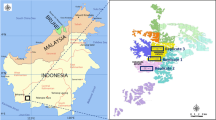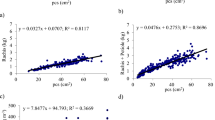Abstract
Banana (Musa AAA) production is declining in central Uganda. A decline in soil fertility is often cited as one of the causes of the declining production. From 1996 to 1998, we studied banana yield responses to N and K fertilization at three sites in Uganda, where plantations ranged in age from 8 to 50 years. Phosphorus was applied to all treatments at 25 kg ha−1, while N and K were applied (kg ha−1) at 0N-0K, 0N-100K, 100N-0K, 100N-100K, and 100N-200K. Fresh fruit yields ranged from 4 to 67 Mg ha−1 yr−1. At one site the yield response to 100N-100K fertilization was significant (p < 0.01). The other sites showed positive but non-significant yield responses to N or NK fertilization. Economic analysis indicated that fertilizer use would be profitable only at the single site with significant yield increases. This site had negligible banana weevil (Cosmopolites sordidus (Germar)) and nematode (Radopholus similis; Helicotylenchus multicinctus) populations whereas the other sites were characterized by either severe nematode or weevil pressure. Fertilizer did not affect the damage caused by either nematodes or weevils. The best predictor of yield (p< 0.001, r 2 = 0.75) was the number of functional leaves during anthesis. Measured soil nutrient parameters were highly variable but fell within sufficiency ranges. Foliar N contents were near diagnostic norms, but K levels fell below them, even when yields were satisfactory, suggesting that norms developed from other regions may not be suitable for Uganda. We conclude that in established plantations soil nutrient status is but one, and often a secondary, factor in the decline of banana yields in the central region of Uganda. Pest and disease infestations that result in reduced plantation productivity will need to be addressed before fertilizer use is likely to make a significant improvement in banana fruit yields.
Similar content being viewed by others
References
Adupa R and Ngambeki DS (1994) Demand and consumption of bananas in Uganda. Afric Crop Sci Conf Proc 1: 379–383
Ambrose E (1984) Research and development in banana crop protection (excluding Sigatoka) in the English-speaking Caribbean. Fruits 39: 234–247
Angeles DE, Sumner ME and Lahav E (1993) Preliminary DRIS norms for banana. J Plant Nutr 16: 1059–1070
Beaufils ER (1973) Diagnosis and recommendation integrated system (DRIS). A general scheme of experimentation and calibration based on principles developed from research in plant nutrition. Soil Sci Bull 1 Univ of Natal, Pietermaritzburg, South Africa
Bekunda MA and Woomer PL (1996) Organic resource management in banana-based cropping systems of the Lake Victoria basin, Uganda. Agr Ecosys Environ 59: 171–180
Churchill WS (1990) My African Journey. Norton: New York (originally published by Hodder and Stoughton, 1908)
Croucher HH and Mitchell WK (1940) Fertilizer investigations with the Gros Michel banana. Dept Sci and Agric Bulletin No. 19 Kingston, Jamaica
Delvaux B (1995) Soils. In: Gowen S (ed) Bananas and plantains, pp 230–257. London: Chapman and Hall
Foster HL (1981) The basic factors which determine inherent soil fertility in Uganda. J Soil Sci 32: 149–160
García R, Guijarro R and Diaz B (1980) Changes in the nutritional status of banana due to the effect of potassium, on red soils in Cuba; their relations with yield and with the control of fertilizing. Potash Rev No 10
Gold CS, Speijer PR, Karamura EB, Tushemereirwe WT and Kashaija IN (1994) Survey methodologies for banana weevil and nematode damage assessment in Uganda. Afric Crop Sci J 2: 309–321
Gold CS, Karamura EB, Kiggundu A, Bagamba F and Abera AMK (1999) Geographic shifts in the highland cooking banana (Musa spp., group AAA-EA) production in Uganda. Inter J Sustain Dev World Ecol 6: 45–59
Hooper DJ (1990) Extraction and processing of plant and soil nematodes. In: Luc M, Sikora RA and Bridge J (eds) Plant parasitic nematodes in subtropical and tropical agriculture, pp 45-68. Oxon, UK: CAB International
IITA (1992) Sustainable food production in sub-Saharan Africa. 1. IITA's contribution. Ibadan, Nigeria: IITA
Landon JR (1991) Soil suitability for bananas (Musa spp). In: Landon JR (ed) Booker tropical soil manual, pp 292–293. Oxon, UK: Booker Tate Ltd
Karamura DA (1999) Numerical taxonomic studies of the East African highland banana (Musa AAA-East Africa) in Uganda. Montpelier, France: INIBAP
Karamura EB and Karamura DA (1995) Banana morphology – part II: the aerial shoot. In: Gowen S (ed) Bananas and plantains, pp 190–205. London: Chapman and Hall
McIntyre BD, Speijer PR, Riha SJ and Kizito F (2000) Effects of mulching on biomass, nutrients, and soil water in banana inoculated with nematodes. Agron J 92: 1081–1085
Ostmark HE (1974) Economic insect pests of bananas. Ann Rev Entomol 19: 161–176
Parish DH (1969) Report on a tour of the banana exporting countries of the Caribbean and comments on the relevance of modern methods of banana production and research to the 'matoke' crop in Uganda. Faculty of Agric, Makerere Univ, Kampala
Parish DH (1970) Interim report on the Makerere banana (matoke) manurial trials: 1968–1970. Faculty of Agric, Makerere Univ, Kampala
Parkinson JA and Allen SE (1975) A wet oxidation procedure suitable for the determination of nitrogen and mineral nutrients in biological material. Commun Soil Sci Plant Anal 6: 1–11
Price NS (2000) The biogeography of the banana nematodes Radopholus similis and Pratylenchus goodeyi. Acta Hort 540: 431–440
Rukazambuga NDTM (1996) The effects of banana weevil (Cosmopolites sordidus Germar) on the growth and productivity of bananas (Musa AAA EA) and the influence of host vigour on attack. PhD Thesis. UK: University of Reading
Speijer PR, Gold CS, Kashaija IN and Karamura EB (1994) Assessment of nematode damage in East African highland banana systems In: Valmayor RV, Davide RG, Stanton JM, Treverrow NL and Roa VN (eds) Banana nematodes and weevil borers in Asia and the Pacific: proceedings of a conference-workshop in Serdang, Malaysia 18–22 April 1994. Los Baños, Phillipines: INIBAP/ASPNET
Ssennyonga JW, Bagamba F, Gold CG, Tushemereirwe WK, Ssendege R and Katungi E (1998) Understanding current banana production with special reference to integrated pest management in southwestern Uganda. Research report of the socioeconomic component of the banana-based cropping systems project to the Rockefeller Foundation
Stover RH and Simmonds NW (1987) Bananas, 3rd edn, London: Longman
Sumner ME (1979) Interpretation of foliar analyses for diagnostic purposes. Agron J 71: 343–348
Turner DW (1990) Modeling demand for nitrogen in the banana. Acta Hort 275: 497–503
Turner DW, Korawis C and Robson AD (1989) Soil analysis and its relationship with leaf analysis and banana yield with special reference to a study at Carnarvon, Western Australia. Fruits 44: 193–203
Twyford IT (1967) Banana nutrition: A review of principles and practice. J Sci Food and Agric 18: 177–183
Uganda Dept Agriculture (1954) Record of investigations no. 3 for the period 1 April 1951 to 31 March 1952. Dept. Agric, Entebbe, Uganda
Uganda Ministry of Agriculture and Cooperatives (1967) Report on Uganda census of agriculture. Vol 3 Ministry Agric and Cooperatives, Entebbe, Uganda
Uganda Ministry of Agriculture, Animal Industries and Fisheries (1992) Report on Uganda national census of agriculture and livestock (1990–1991). Vol 3 Crop Area, Yield and Production. Ministry Agric, Animal Industries and Fisheries, Entebbe, Uganda
Walmsley D, Twyford IT and Cornforth IS (1971) An evaluation of soil analysis methods for nitrogen, phosphorus and potassium, using banana. Trop Agric (Trin) 48: 141–155
Wortmann CS, Bosch CH and Mukandala L (1994) Foliar nutrient analyses in banana grown in the highlands of East Africa. J Agron Crop Sci 172: 223–226
Wortmann CS and Kaizzi CK (1998) Nutrient balances and expected effects of alternative practices in farming systems of Uganda. Agric Ecosys Environ 71: 115–129
Author information
Authors and Affiliations
Corresponding author
Rights and permissions
About this article
Cite this article
Smithson, P., McIntyre, B., Gold, C. et al. Nitrogen and potassium fertilizer vs. nematode and weevil effects on yield and foliar nutrient status of banana in Uganda. Nutrient Cycling in Agroecosystems 59, 239–250 (2001). https://doi.org/10.1023/A:1014462923539
Issue Date:
DOI: https://doi.org/10.1023/A:1014462923539




